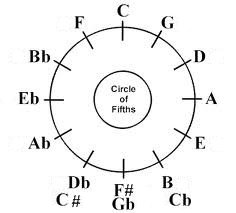
The Circle of Fifths is a simple concept which dominates scale theory, key theory, harmony...so much of music.
The interval of a fifth is the distance between two notes where, counting the first note, the last note and all the notes between, includes five notes. The fifth above C is G (C D E F G). For the fifth to be a perfect fifth it must be included in the key of the starting note. A perfect fifth above C is G, a perfect fifth above G is D, a perfect fifth above D is A, and so on. One last point. To go up a perfect fifth, or to go down a perfect fourth you arrive at the same note, just an octave apart.
So...let's start with an Gb
Up a perfect fifth is Db
Down a perfect fourth is Ab
Up a perfect fifth is Eb
Down a perfect fourth is Bb
Up a perfect fifth is F
Down a perfect fourth is C
Up a perfect fifth is G
Down a perfect fourth is D
Up a perfect fifth is A
Down a perfect fourth is E
Up a perfect fifth is B
Down a perfect fourth is F#
At this point an interesting thing happens. We arrive (almost) one octave above the note we started on. It's wrong by about 1%. To simplify things we say these notes (F# and Gb) are “enharmonic” and function on the keyboard as the same note. (And from this fact comes the problem of temperament, which I will not go into.)
Now, look at the circle and consider a few things.
The order of the sharps is:
See it there in the circle?
The order of the flats is:
Again, sitting there in the circle.
The order of the names of the sharp keys is:
The order of the names of the flat keys is:
This “Circle of Fifths” lies at the heart of it all...
Want to know more? Here's a great article with more information. Also here's an interactive exercise using the circle.